
The C. C. Crowell House is a historic house in Somerville, Massachusetts. Built about 1890, it is a good example of Queen Anne Victorian architecture built from a pattern book design. The house was listed on the National Register of Historic Places in 1989.
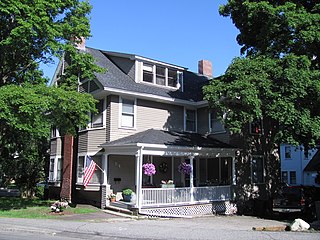
The Brande House is a historic house in Reading, Massachusetts. Built in 1895, the house is a distinctive local example of a Queen Anne Victorian with Shingle and Stick style features. It was listed on the National Register of Historic Places in 1984.

129 High Street in Reading, Massachusetts is a well-preserved, modestly scaled Queen Anne Victorian house. Built sometime in the 1890s, it typifies local Victorian architecture of the period, in a neighborhood that was once built out with many similar homes. It was listed on the National Register of Historic Places in 1984.

77 Howard Street in Reading, Massachusetts is an excellent example of a well preserved Queen Anne Victorian house. It was built in the 1890s, during the town's growth as a railroad suburb of Boston. It was listed on the National Register of Historic Places in 1984.
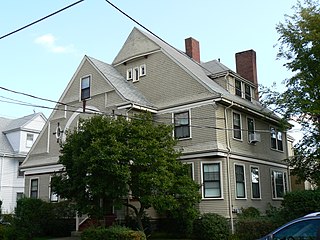
The House at 5–7 Winter Street in Arlington, Massachusetts is a rare late-19th century two family house in East Arlington. The wood-frame house was built in 1895 by John Squires, who owned a garden farm. It was built as a speculative venture at a time before Arlington's market gardeners began selling their land off for development. The building exhibits well-preserved Queen Anne styling, with asymmetric massing characteristic of that style, and a judicious use of decorative cut wood shingles.

The Yale Avenue Historic District is a residential historic district near the center of Wakefield, Massachusetts. It encompasses eight residential properties, all but one of which were developed in the 1860s and 1870s, after the arrival of the railroad in town. These properties were built primarily for Boston businessmen, and mark the start of Wakefield's transition to a suburb.
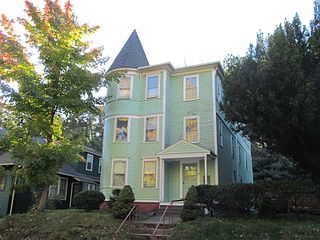
The Crystal Street Historic District is a group of three triple deckers facing University Park in the Main South area of Worcester, Massachusetts. The houses appear to have been built for developer James Harrop, who lived at 30 Crystal Street and owned them for 35 years. At the time of their construction circa 1892, Harrop is described in city directories as a wool sorter, but, over the following years, he became a real estate developer. The houses were built at a time when the area was experiencing significant development due to the extensions of the electrified street cars to the area. Early residents of the buildings would have been skilled laborers and middle-class white collar workers.

The David Hunt Three-Decker is a historic triple decker in Worcester, Massachusetts. Built about 1900, it is a well-preserved example of the building type with Queen Anne Victorian features. It was listed on the National Register of Historic Places in 1990.
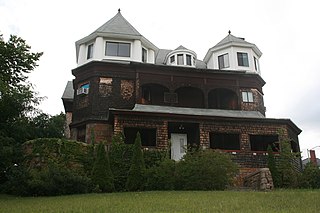
The Jesse Moore House is a historic house at 25 Catherine Street in Worcester, Massachusetts. Completed in 1891, it is one of the city's well-preserved examples of high-style Queen Anne architecture with Shingle style features. The house was listed on the National Register of Historic Places in 1980.

The E. Sybbill Banks House is a historic house at 27 Appleton Street in Waltham, Massachusetts. Built in 1892, it is an excellent local example of vernacular Queen Anne styling. It was built for E. Sybbil Banks, the spinster daughter of Nathaniel Prentice Banks who was also a prominent local civil servant. The house was listed on the National Register of Historic Places in 1989.

The House at 15 Lawrence Street in Wakefield, Massachusetts is a well-preserved Queen Anne house with a locally rare surviving carriage house. It was built in the early 1870s, and was listed on the National Register of Historic Places in 1989.

The House at 20 Lawrence Street in Wakefield, Massachusetts is a complex residential structure with elements of Queen Anne, Stick style, and Colonial Revival style. Built about 1880, it was listed on the National Register of Historic Places in 1989.
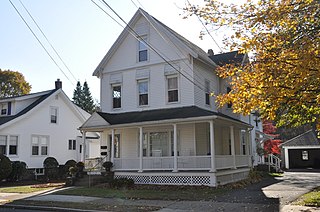
The House at 54 Spring Street in Wakefield, Massachusetts is a well-preserved Queen Anne Victorian house. The 2+1⁄2-story house was built c. 1889–90, and is most notable for its detailed shingle work. The house has an L shape, with a porch that wraps around the front and right side, into the crook of the L. The windows are topped by shed-roofed hoods with cut shingles, and there are bands of decorative shingle work filling the north side gables.

The House at 11 Wave Avenue in Wakefield, Massachusetts is a well-preserved example of Queen Anne/Stick-style architecture. Built between 1875 and 1888, it was listed on the National Register of Historic Places in 1989.

The William E. Alden House is a historic house at 428 Hamilton Street in Southbridge, Massachusetts. Built in 1882 for a prominent local businessman, it is a fine example of a modest home with Queen Anne and Stick style decoration. It was listed on the National Register of Historic Places in 1989.
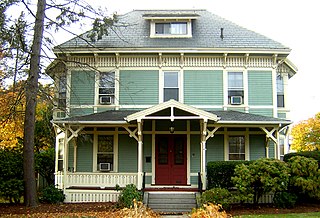
The George A. Barker House is a historic house located at 74 Greenleaf Street in Quincy, Massachusetts. Built in the late 1870s for the son of a local granite quarry owner, it is a good local example of Queen Anne architecture with Stick style details. The house was listed on the National Register of Historic Places on September 20, 1989.

The Housatonic Congregational Church is a historic church building at 1089 Main Street in Great Barrington, Massachusetts. Built in 1892 it is a prominent local example of Queen Anne Revival architecture, and was listed on the National Register of Historic Places in 2002. It is now home to the Unitarian Universalist Meeting of South Berkshire.

The Roger Sullivan House is a historic house at 168 Walnut Street in Manchester, New Hampshire. Built in 1892, it is the only known example of residential Queen Anne architecture by local architect William M. Butterfield, and is one of the city's finest examples of the style. It was listed on the National Register of Historic Places in 2004.

The Austin Pangburn House is a historic house at Main and Austin Streets in Pangburn, Arkansas. It is a 1+1⁄2-story wood-frame structure, with irregular massing typical of the Queen Anne period. It has a hip roof, with projecting gables that are finished in bands of decoratively cut wooden shingles, with novelty siding on the rest of the house. A porch wraps around two sides, supported by Doric columns. Built c. 1908, it is a well-preserved example of period construction in White County.

The Harrington House is a historic house at 88 North Road in Bethel, Vermont. Built in 1890–91, it is a fine example of high-style Queen Anne Victorian architecture, a relative rarity in the state. The house was listed on the National Register of Historic Places in 1983. Its most recent additions have included a restaurant, bed and breakfast inn.























